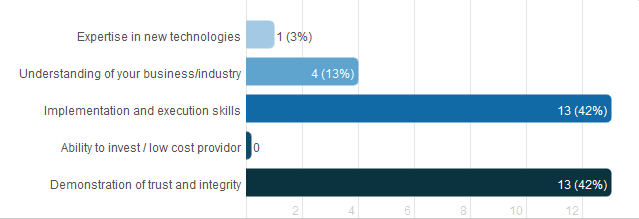
by Adam L Stanley | Sep 13, 2011 | Relationships, Technology, Vendors and Partners
Vendor Relationships Critical Partnership Element #5: Demonstration of Trust and Integrity
I recently ran an informal poll on LinkedIn that asked a relatively simple question:
Today’s IT leaders depend on a plethora of new players to drive change. What should CXOs most look for in a partner?
Here are the results¦.

Webster’s dictionary defines trust as the “assured reliance on the character, ability, strength, or truth of someone or something.†A favorite quote sums up the importance of this small word.
Trust is like an eraser, it gets smaller and smaller after every mistake.
Thus, it was no surprise to me that so many people in my poll rated this element as the most important trait to look for in a partner.
I’ve blogged on some of the elements that garnered the least votes but the most comments as being table stakes. To cover this important Trust element, which tied for first place, I’ve invited John Vincent, a founder of Broadgate Consultants Ltd based in London, to guest blog. In his post below, John speaks of an equation used in assessing trust and highlights a critical point that Trust is not easy to come by. Trust, he says, must be both earned and sustained. If you are a vendor or IT partner, I’m hoping his perspective will help you keep YOUR trust eraser nice and strong. If you are a CXO, I hope it helps you know what to look for in assessing and building relationships with your partners.
 In Relationship,
In Relationship,
Adam
“TRUST must be EARNED and SUSTAINED
By John Vincent, Broadgate Consultants Ltd.
Recently Adam L. Stanley (@ALSWharton) ran a very interesting poll on LinkedIn around the theme of technology change with the question, What should CXOs most look for in a partner? (See above for results). Of the 5 categories, ranked equal first alongside Implementation and Execution was Demonstration of Trust and Integrity, with 43%. It is this theme that I’d like to explore.
To be truly considered a trusted advisor to clients and colleagues the status has be both earned and sustained. At the optimal level, it is a symbiotic relationship between CXO and partner i.e. A relationship of mutual benefit or dependence. So many times we see this relationship distorted or the balance skewed, such as contracts where the partner either “buys the deal†or has commercials tied down to a level to which they cannot deliver. Familiar? Or global partner agreements that are driven from a success in one business domain which is then shoe-horned into a non-fit for purpose world. Seen that?
The Trust Equation
The Trust equation talks about it being the sum of Credibility, Reliability and Intimacy divided (or diluted) by Self Orientation. It is a good general measure. Without going into the mechanics and metrics, let’ss look at the constituent parts.
Credibility
This area is most commonly achieved in a relatively moderate amount of time. The quantitative aspects, or believability, can be established through demonstrating technical capability and advice, or checked through references etc… The softer side, such as honesty, is more related to comfort and rapport. In the survey it is also strongly related to Integrity. In the CXO Partner relationship this can be eroded through traits such as over exaggeration, anticipating needs rather than listening to the problems and promising, or over stating, capability which doesn’t exist. I saw a colleague a few months ago who had moved from the client to the supply side and she was very unhappy at the practice of claiming non-existent service capability and subsequently resigned.
Reliability
It is taken as given that partners should be reliable, demonstrate consistent behaviours and be dependable. Right? However, the CXO vocabulary is littered with anecdotes of partnership agreements gone bad. We hear a lot of talk of the A Team at the outset being swapped for the Team during execution. Or surprise that the bread-and-butter services of some of the big partner firms turn out to be far from expectations or developed on the job. And remember it’s not uni-directional. Reliability also applies to the client side in the relationship. For an effective and efficient model there are obligations on both sides. Reliability applies all round in areas such as communications, timeliness, clarity and consistency.
Intimacy
Managing change in today’s climate has never been more difficult. CXOs should seek trusted partners that they can engage with on a different level to drive often challenging agendas. In a true partnership, both sides should be open to explore solutions without keeping important information in the back pocket. This includes being clear in the blockers and issues on both sides – whether that is internal client constraints, desires, commercial goals etc – as well as limitations or short falls in delivery on the partner side. Difficult, yes? But if the personal things relating to the engagement get shared it can bring an emotional closeness to benefit all. Of course, this takes more time in terms of the trust equation.
Self Orientation
This is the main source of dilution in demonstrating trust. Partners who have a tendency to jump straight to a solution without listening, claim the higher intellectual ground, fail to grasp a CXOs motivations, or are openly more interested in themselves or the deal will quickly destroy any of the good parts of the equation. We’ve all sat in front of partners where it is clear that they are winging an answer on the basis that time back at the office will allow for a veneer of credibility to be placed over the proposal. Also, an over willingness to drop in a catalogue of high profile names or organisations where they have had market leading proposition or success can be another example of excessive self-orientation. Really…Let’s take a look at some of those in more detail…can we see the Case Studies ?…talk to the CIO ?
The demonstration of Trust and Integrity in the CXO Partner relationship is very important. The old safety net practice doesn’t stand up to scrutiny anymore. I am not surprised by the results of the survey and hope that we at Broadgate can continue to keep at the forefront.
JV
John Vincent
Broadgate Consultants Ltd
21 New Street
London EC2M 4HR
www.broadgateconsultants.com
twitter.com/broadgateview
Linkedin/broadly speaking
Which is Most Important?
So, which would YOU put FIRST? Subscribe to this blog or come back for discussions on all five of the vendor relationship characteristics. Meanwhile, send me a tweet or post your comments below.
Vendor Relationship Series –
“Trust – Guest blog by John Vincent of Broadgate Consultantsâ€Â | “Have you MET the CFO? | “Experts or Frauds?”

by Adam L Stanley | Aug 8, 2011 | Relationships, Technology, Vendors and Partners
Vendor Relationships Critical Partnership Element #4: Ability to invest / Low Cost Providor
I recently ran an informal poll on LinkedIn that asked a relatively simple question:
Today’s IT leaders depend on a plethora of new players to drive change. What should CXOs most look for in a partner?
Here are the results ….

My next several blog posts will focus on each of the possible answers and share my thoughts, along with those of my respondents (public and otherwise), on why each of them are in fact critical.
I start with the one that not surprisingly received NO VOTES from my vendor-heavy polling group, “Ability to invest / low cost provider†and I will call this blog post “Have you MET the CFO?â€
Why Cost Matters
- The IT department has become a crucial partner with the business units to achieve greater ROI (return on investment). With IT costs being a significant chunk of shared services costs for the typical corporation, there is tremendous visibility on effectively managing these costs.
- According to a 2010 survey from Gartner and the Financial Executives’ Research Foundation (FERF), The CFO is increasingly becoming the top technology investment decision maker in many organizations. The study concluded that “CIOs must understand the impact their CFOs have on technology decisions in their organizations and ensure that they are providing the CFO with the appropriate understanding of technology, as well as communicating the business value that can be achieved.â€
- Every CTO or CIO has had at least one conversation in the last 24 months where he or she was asked to “discuss our objective to reduce overall IT costs by X% while maintaining or improving service quality and supporting our business growth.â€
- While there are MANY CFOs out there that have significant experience in technology, all too often CFOs view IT as a cost-center only, a shared service that is ripe for chronic annual reductions with or without regard for quality of service or innovation.
- According to a 2011 Gartner/FEI study, only about a quarter of the CFOs surveyed had confidence that their own IT organization “has the organizational and technical flexibility to respond to changing business priorities,” or “is able to deliver against the enterprise/business unit strategy.”
- The survey showed that CFOs “are inclined to invest in technologies where competitive advantage can be demonstrated, analysis and decision-making is assisted, or efficiencies and cost reduction are achieved.†See more
The fact is, no matter how much you want to pick vendors that have the coolest tools and the most trustworthy teams, each technology investment MUST generate positive return for our company. And, while there are SEVERAL factors in ROI, cost remains one of the most visible, even if not the most impactful. To get the attention of your CFO and thus your top management overall, you must be prepared with a cost effective value driving solution. So, a vendor that wants to bring something new to the table will often be asked to invest in the relationship by significantly reducing cost of entry for the client.
Vendor Relationships Tips for CIO/CTO
Yes, cost is critical, and yes vendors must realize this and be prepared to make an investment in a new relationship. That said, here are my thoughts on how the CIO/CTO should work with vendors to create win-win relationships.
1. Think about the marathon. Is this vendor someone that you want to work with in the future? Remember that a buyer’s market will ALWAYS become a seller’s market.  Payback is a …. Bummer. The recession may give you the upper hand now but when markets rebound, memories are long and you may be on the other end of the negotiating table. Think about the relationship as long-term and act accordingly. Negotiate in good faith, with integrity, and with fairness.
2. Remember tradeoffs. As you’ve often told your CEO/CFO, cost and quality are inversely relational. Do you really want to negotiate so hard your vendor has no ability to make any profit, thus forcing them to cut corners, bring junior resources, or otherwise fail? We signed a deal recently that we estimated would save us “an insane amount†in a particular area of our infrastructure. We squeezed the vendor so hard that the project was, frankly, a nightmare. The disruption to the business, the rework and errors, and the added costs to bring in additional resources took away much of the savings. Neither our team nor the vendors were happy in the end.
Mark Church, who was my Account Manager at Cisco when we awarded them “Vendor of the Year 2010â€, said it best in his response to the poll:
“I think one must evaluate both sides of the equation: Is it better to be the lowest initial cost, or the solution with highest return? Whenever possible, partners must strive for both but should be rewarded for driving transformation through innovation.â€
Amen!
3. Be authentic and honest. If you have trust in this vendor (and given this was in the top two responses in my survey I’m guessing you agree this is important), you should openly discuss cost challenges and ways the vendor may help your business. For years, I have had a practice of writing my annual cost reduction target in large numbers at the top of my office white board. Every vendor partner that meets with me can see the target. Vendors that are part of my strategic partner circle actively and regularly come prepared with ideas for helping me achieve the target.
I am proud of the relationships I have built with my vendors over the years and very much appreciative of the investments they have made to help me drive value for our clients. Most importantly, I hope they would all work with me again in the future based on the relationship we have built. While no one voted for “Ability to invest / low cost providerâ€, I would argue that perhaps that is because this more than the others could be considered “table stakesâ€. If you are so expensive I could not even begin to bring your technology to our executives – especially the CFOs of the world – trust, execution skills, and business knowledge just will not matter.
Which is Most Important?
Founder and CEO of New Relic Lew Cirne (twitter @sweetlew), said he was torn in making a selection. “Great list of options, nearly all are critically important,†he wrote in his comments after voting. I agree completely! All five of the characteristics are important. Frankly, the perfect vendor should have all, but in the era where there is a new technology, a new tool, some new social media outlet popping up every day, which would YOU put FIRST?
I would love to hear from you!
Be well. Lead on.
Adam
Vendor Relationship Series
“Trust – Guest blog by John Vincent of Broadgate Consultantsâ€Â | “Have you MET the CFO? | “Experts or Frauds?”
Resources:
- How To Squeeze Top Value From Your Technology Vendors – Investors.com – http://bit.ly/rjXNDM
- Vendor Negotiation: Squeeze Now, Pay Later CIO.com – http://t.co/KpMfCen (horrible, short-term strategy that was popular in early 2000s after the first tech bust)
- Forrester: How to squeeze your vendors | ITworld – http://bit.ly/nZRuBn (more balanced approach in worst days of recession – late 2008)
- CFOs Lack Faith in CIOs and IT Teams, Survey Shows CIO.com – http://bit.ly/ovklhQ
- The role of the CFO in cost reduction – http://bit.ly/oPrZsl

Adam Stanley
Adam L. Stanley Connections Blog
Technology. Leadership. Food. Life.
AdamLStanley.com
Follow me on Twitter | Connect with me on Linked In | “Like†me on Facebook


 In Relationship,
In Relationship,




